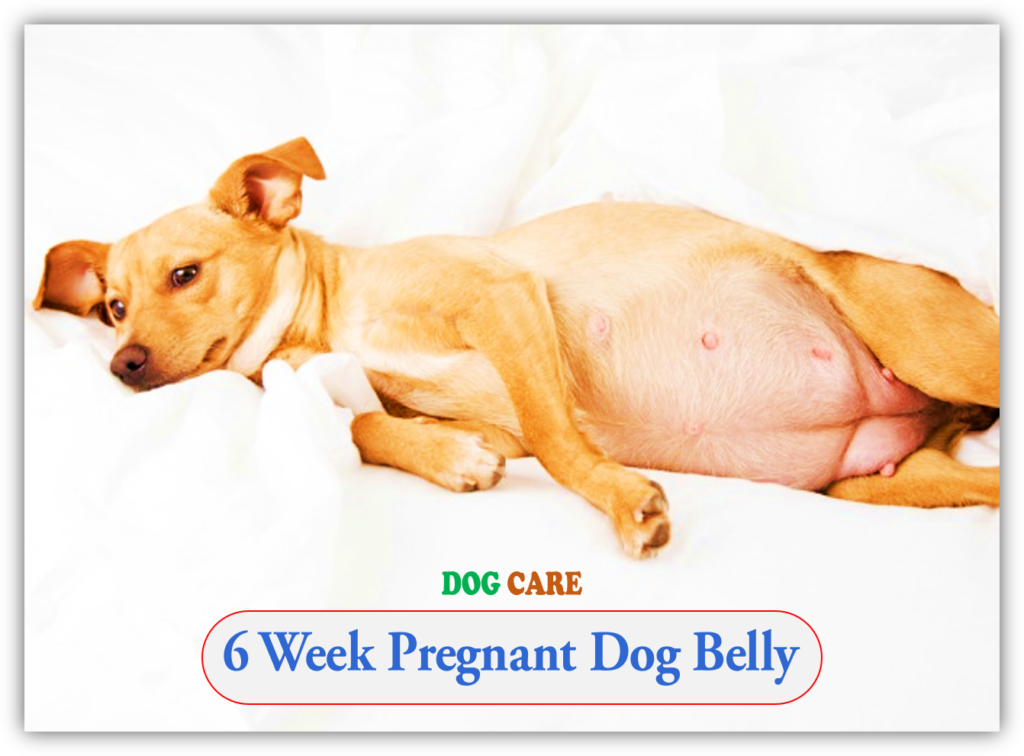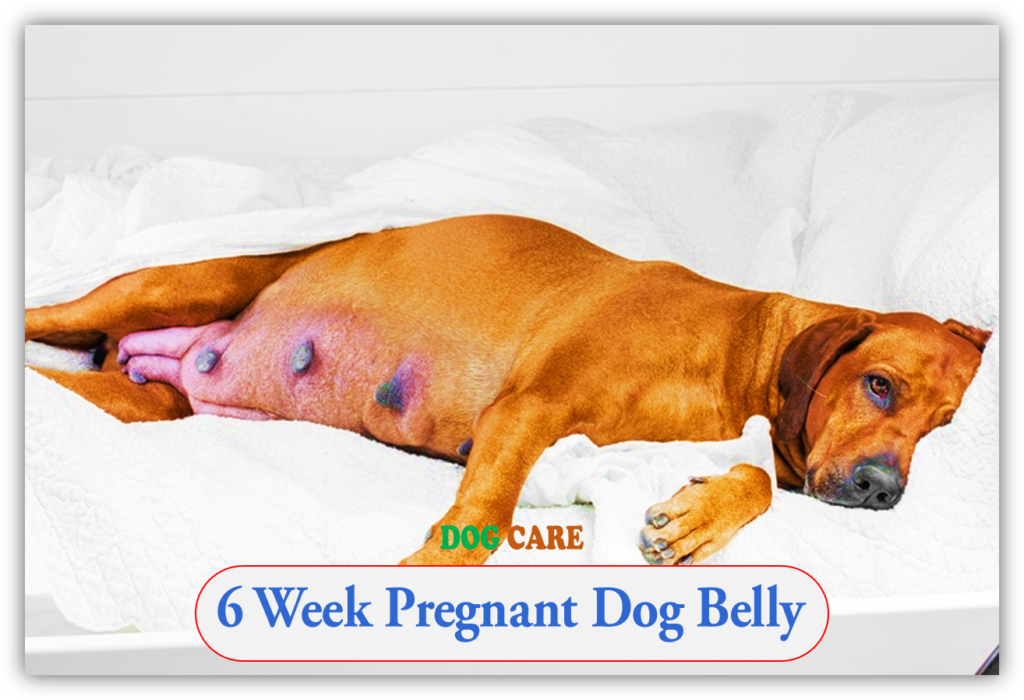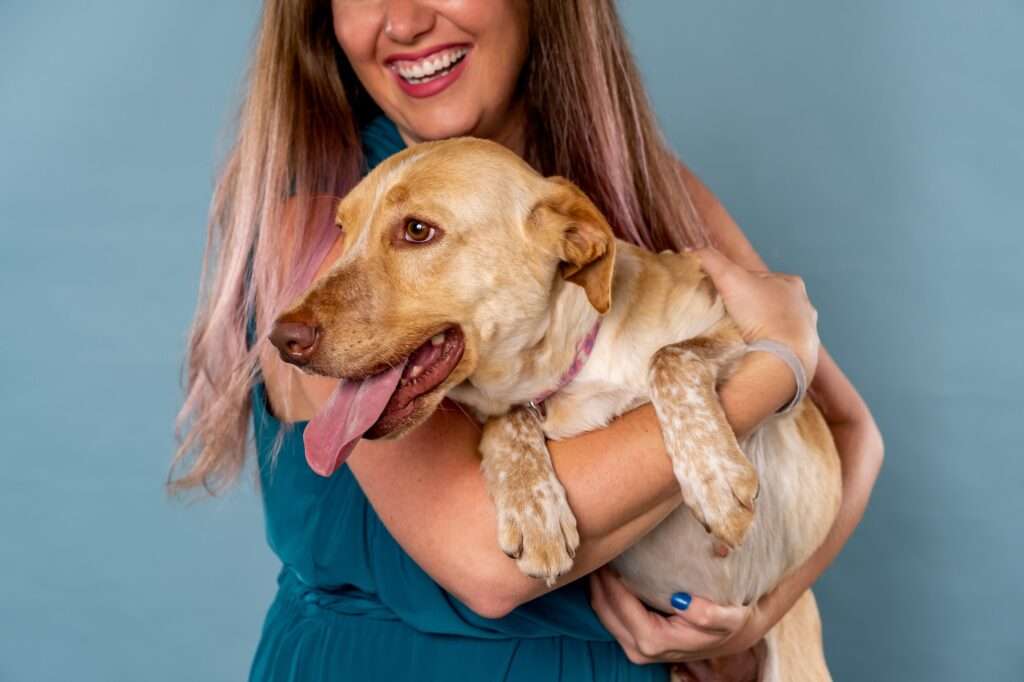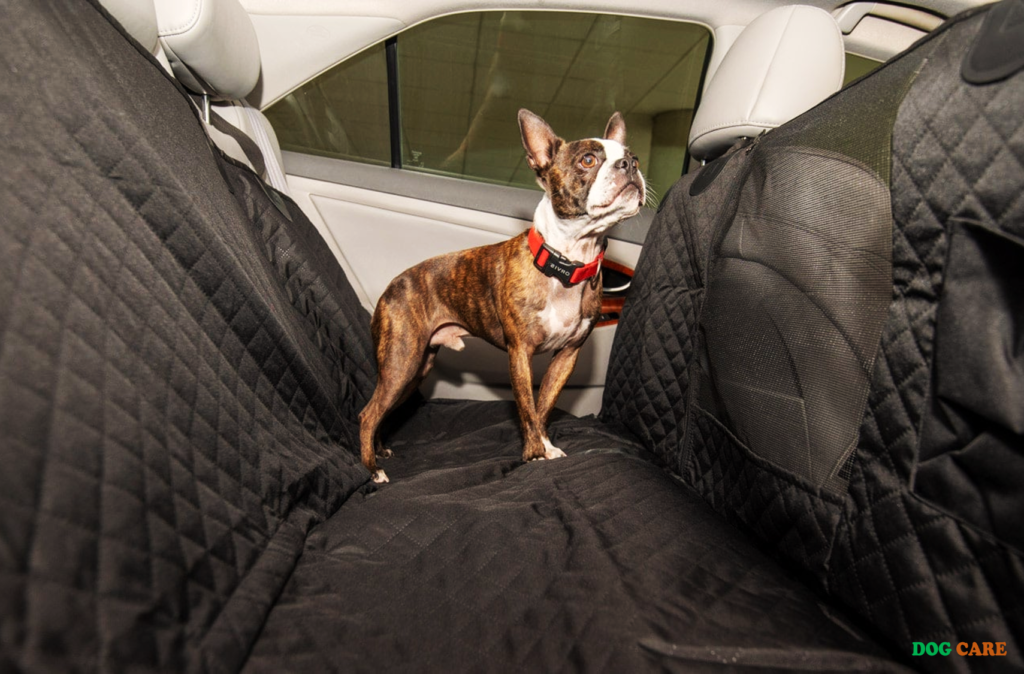6 Week Pregnant Dog Belly – A dog’s belly during the 6th week of pregnancy will start to appear larger as the puppies develop. At this stage, you may notice your dog’s breasts becoming swollen and her nipples darkening in color.
Additionally, she may experience changes in her appetite and behavior. It is important to provide your dog with proper nutrition and regular veterinary care to ensure a healthy pregnancy. Pay attention to any signs of discomfort or distress and consult your veterinarian if you have any concerns.

Understanding Dog Pregnancy
Welcoming a new generation of puppies into the world can be an exciting and rewarding experience. However, understanding the process of dog pregnancy is crucial for ensuring the health and well-being of both the mother and her puppies. In this article, we will explore the stages of dog pregnancy, signs to look out for, and how to provide the appropriate care and nutrition during this delicate time.
The Stages Of Dog Pregnancy
Just like humans, the journey of dog pregnancy is divided into distinct stages. It is essential to familiarize yourself with these stages to accurately monitor your dog’s progress and provide the necessary care. Let’s take a closer look at the three stages of dog pregnancy:
::1. Stage 1 – Fertilization and Embryo Development: This initial stage occurs after the successful mating of the female dog. Here, the sperm meets the egg, resulting in fertilization. The embryos then travel to the uterus, where they implant and develop.
::2. Stage 2 – Organ Development: As the pregnancy progresses, the embryos transition into the organ development stage. During this period, the puppies’ vital organs, including the brain, heart, and lungs, begin to form. This critical phase sets the foundation for their overall health and well-being.
::3. Stage 3 – Final Growth and Preparation: In the final stage of pregnancy, the puppies’ skeletons develop, and their bodies rapidly grow in size. The mother dog’s belly becomes more prominent, demonstrating the growth occurring within. It is crucial to provide proper care during this stage to ensure the puppies are healthy and ready for birth.
Signs Of Dog Pregnancy
While the stages of dog pregnancy are characterized by internal changes, there are noticeable signs that can help determine if your dog is pregnant:
- Changes in Appetite: Some dogs may experience increased or decreased appetite during pregnancy.
- Enlarged Nipples: The mother dog’s nipples will become larger and may darken in color as her body prepares for nursing.
- Behavioral Changes: Pregnant dogs might exhibit mood swings, restlessness, or become more affectionate.
- Abdominal Growth: As the pregnancy progresses, the dog’s abdomen will gradually enlarge, signaling the growth of the puppies.
- Weight Gain: A pregnant dog typically gains weight due to the developing puppies and increased fluid retention.
It’s important to remember that these signs may vary between individual dogs, and consulting with a veterinarian is the best way to confirm your dog’s pregnancy.
Care And Nutrition During Dog Pregnancy
Proper care and nutrition are vital for ensuring the health of the mother dog and her developing puppies. Consider the following guidelines to support a healthy pregnancy:
- Veterinary Consultation: Schedule regular check-ups with your veterinarian to monitor the progress of the pregnancy and address any concerns.
- High-Quality Diet: Provide a balanced and nutritious diet specifically formulated for pregnant dogs. Consult with your vet to determine the appropriate diet plan.
- Supplements: Your vet may recommend prenatal supplements to ensure your dog receives essential vitamins and minerals.
- Exercise: Encourage moderate exercise to keep your dog fit and maintain muscle tone. However, be cautious not to overexert her.
- Comfortable Environment: Create a safe and comfortable space for your dog to rest during the later stages of pregnancy.
- Whelping Area Preparation: Set up a clean and warm whelping area where your dog can give birth and care for her puppies.
By following these guidelines and providing attentive care, you can ensure a healthy journey for your pregnant dog and prepare for the arrival of her precious puppies.
Development Of The Dog Embryo
During the six weeks of pregnancy, a remarkable transformation occurs within the pregnant dog’s belly. From the initial fertilization and implantation to the formation of organs, limbs, and facial features, every stage is crucial for the healthy development of the dog embryo. Let’s dive into the fascinating journey of the dog embryo and witness the miracle of life unfolding.
Week 1: Fertilization And Implantation
Week 1 marks the beginning of pregnancy for your dog. After successful mating, the male sperm fertilizes the female dog’s egg, resulting in the formation of an embryo. This tiny cluster of cells rapidly divides as it travels through the dog’s reproductive system, aiming to reach the uterus. Once it reaches its destination, the embryo implants itself into the uterine wall, where it will receive nourishment and support for further growth.
Week 2: Formation Of The Embryo
By week 2, significant progress is made in the embryo’s development. The embryo, now called a blastocyst, continues to grow and multiply. The outer layer of cells differentiates to form the placenta, which will provide nutrients and oxygen to the growing puppy. Meanwhile, the inner cell mass starts to arrange itself, laying the foundation for the future organs and tissues of the puppy.
Week 3: Organ Development Begins
At week 3, the embryo’s development enters a crucial phase as organogenesis begins. The neural tube starts to form, along with the heart, liver, and primitive circulatory system. The tiny puppy’s spinal cord and brain also take shape during this period. While these organs are developing, the circulatory system begins to supply blood to sustain the future puppy’s growth.
Week 4: Development Of Limbs And Facial Features
By week 4, the developing puppy exhibits limb buds, which will eventually grow into legs and paws. The embryo’s facial features, such as the eyes, snout, and ear rudiments, become discernible. As the internal organs continue to mature, the puppy starts to take on a recognizably canine shape. It’s an awe-inspiring sight to witness the formation of limbs and the first glimpse of what the adorable puppy might look like.
Week 5: Growth And Maturation
During week 5, the puppy’s growth rate accelerates rapidly. It gains weight, and its body proportions become more defined. The skeletal system strengthens, and the features that define the breed characteristics begin to develop. The puppy’s organs continue to mature, and its senses, such as hearing and touch, start to develop. At this stage, the dog embryo is nearly fully grown and ready for the final stage of gestation.
Week 6: The Miracle Of Life
By week 6, the dog embryo has grown into an almost complete miniature dog. The internal organs are fully formed, and the skeleton is ossified. The puppy is now known as a fetus. During this final week, the fetus undergoes further refinement and fine-tuning, preparing itself for the outside world. The pregnant dog’s belly might become more noticeably rounded, as the growing fetus presses against the uterine wall, ready to greet the world in just a few weeks.
Caring For A 6-week Pregnant Dog
During the 6th week of your dog’s pregnancy, it’s crucial to provide proper care and attention to ensure the well-being of both the mother and the growing puppies. By consulting with a veterinarian, creating a comfortable environment, providing a balanced diet, and closely monitoring health and well-being, you can help your dog have a smooth and healthy pregnancy. Additionally, taking preventative measures to avoid miscarriage or complications will help ensure a successful pregnancy.
Consulting With A Veterinarian
One of the first steps in caring for a pregnant dog is to consult with a veterinarian. They are the professionals who can provide expertise and guidance throughout the pregnancy journey. Schedule regular check-ups with your vet to monitor the progress of the pregnancy, assess the health of the mother, and discuss any concerns or potential risks. Your veterinarian will be able to provide specific advice tailored to your dog’s individual needs and address any questions or issues that may arise.
Creating A Comfortable Environment
A comfortable environment plays a significant role in supporting a pregnant dog during the 6th week of pregnancy. Provide a quiet and secluded space where your dog can rest undisturbed. Make sure the area is free from loud noises and excessive activity to minimize stress. Consider providing a properly-sized whelping box with soft bedding for her comfort. This will serve as a safe place for both the mother and the puppies once they arrive. It’s essential to maintain a clean environment by regularly cleaning the whelping box and ensuring proper ventilation.
Providing A Balanced Diet
A balanced diet is crucial for the well-being of your dog and her growing puppies. During the 6th week of pregnancy, it’s important to focus on high-quality, nutrient-dense food that meets the increased energy and nutritional requirements. Consult with your veterinarian to determine the appropriate diet for your dog. They may recommend a specially formulated pregnancy diet or suggest adding supplements to ensure she receives essential nutrients like folic acid and calcium. Remember to provide fresh water at all times, as hydration plays an essential role in maintaining a healthy pregnancy.
Monitoring Health And Well-being
Regularly monitoring your dog’s health is vital throughout the pregnancy. Observe her behavior, appetite, drinking habits, and restroom frequency. Keep an eye out for any unusual signs or symptoms, such as lethargy, lack of appetite, or discharge. If you notice anything concerning, contact your veterinarian promptly. The veterinarian may recommend additional tests or screenings to ensure the health of your dog and the developing puppies.
Preventing Miscarriage Or Complications
Preventing miscarriage or complications is an essential aspect of caring for a 6-week pregnant dog. Minimize any potential risks by preventing exposure to infectious diseases and parasites. Regularly deworm your dog under veterinary guidance, and keep her up to date on vaccinations. Avoid strenuous activities or rough play that could lead to injuries. Provide a stress-free environment and ensure a proper diet and hydration. If you notice any signs of distress or potential complications, consult with your veterinarian right away.
Preparing For The Arrival Of Newborn Puppies
Preparing for the arrival of newborn puppies is an exciting time for dog owners. As your dog reaches 6 weeks of pregnancy, it’s important to start making preparations to ensure a smooth and comfortable experience for both mother and puppies. This includes creating a nesting and whelping area, gathering essential supplies, and familiarizing yourself with the whelping process and postnatal care. In this article, we will guide you through each step to help you create a welcoming environment for your dog’s soon-to-be-born puppies.
Nesting And Whelping Area
Creating a cozy and safe nesting and whelping area is crucial for the comfort and safety of both the mother dog and her puppies. This area should be quiet, warm, and easily accessible to the expectant mother. Here are some key considerations:
- Choose a quiet and secluded location in your home where the mother dog can have privacy during the whelping process.
- Ensure the area is warm, maintaining a temperature between 75 to 80 degrees Fahrenheit (24 to 27 degrees Celsius). You can achieve this by using a heat lamp or heating pad, making sure to place it away from direct contact with the mother and puppies to prevent burns.
- Line the area with soft bedding such as clean towels or blankets. Avoid using materials that can pose a suffocation risk or easily be chewed on.
- Create a whelping box by using a large cardboard box or purchasing a commercial whelping box. It should provide enough space for the mother dog to move around comfortably, but not too large to prevent the puppies from straying too far.
- Make sure the whelping box has low sides to allow the mother dog to easily enter and exit, while preventing the puppies from escaping prematurely.
Gathering Essential Supplies
Having the necessary supplies ready before your dog gives birth is essential for a smooth whelping process. Here’s a checklist of items you should have:
| Whelping kit: | Include items such as clean towels, heating pads, clean scissors, dental floss for tying off umbilical cords, and a thermometer to monitor the mother’s temperature. |
| Non-skid mats: | Place these under and around the whelping area to prevent the mother dog from slipping and causing injury. They also help absorb any accidental spills or messes. |
| Puppy nursing bottles and formula: | In case the mother is unable to nurse or needs assistance, these can be used to feed the newborn puppies. Consult with your vet to ensure you have the appropriate formula. |
| Weighing scale: | This will allow you to monitor the puppies’ weight gain and overall health as they grow. |
| Disposable gloves: | These are essential for maintaining hygiene during the whelping process and newborn care. |
Preparing For The Whelping Process
The whelping process can be unpredictable, so it’s important to be prepared. Here are some tips to help you get ready:
- Monitor your dog closely: Watch for signs of labor, such as restlessness, loss of appetite, nesting behavior, and a drop in body temperature. Keep track of any changes and inform your veterinarian.
- Contact your veterinarian: Establish open communication with a vet in case of emergency or if you have questions during the whelping process.
- Create a birth plan: Discuss with your vet what to expect during the whelping process and the signs of complications that require immediate veterinary assistance.
- Set up a whelping diary: Record important details such as the time each puppy is born, their weights, and any observations about their health.
- Prepare an emergency contact list: Include the contact information of your veterinarian and a 24-hour emergency vet clinic in case you need immediate assistance.
- Keep calm and stay vigilant: Be present during the whelping process to help the mother if needed, but allow her to take the lead. Avoid unnecessary interference and keep the environment as stress-free as possible.
Postnatal Care And Support
After the puppies are born, they will require proper care and attention. Here are some essential guidelines to follow:
- Allow bonding time: Give the mother dog ample time to bond with her puppies. Avoid handling the newborns excessively during the first few days.
- Monitor feeding: Make sure all the puppies are nursing properly and gaining weight. Consult your vet if you notice any issues.
- Keep the whelping area clean: Replace soiled bedding regularly to maintain hygiene and prevent the spread of infections.
- Socialize the puppies: Introduce gentle handling and exposure to different sights, sounds, and textures as they grow to promote healthy development.
- Schedule a veterinary check-up: Plan a visit to the vet within the first week to ensure the mother and puppies are healthy. The vet can also provide guidance on vaccination and deworming schedules.
By following these guidelines and being well-prepared, you can provide the necessary support and care for your dog and her newborn puppies. Remember to consult with your veterinarian for personalized advice and support throughout this exciting journey.
Common Concerns During A Dog’s 6th Week Of Pregnancy
Vet Visits And Medical Check-ups
When it comes to taking care of a 6-week pregnant dog, regular vet visits and medical check-ups are crucial. These visits not only ensure the well-being of your furry friend but also help address any potential health concerns and ensure a healthy pregnancy and safe delivery. In this section, we will explore the importance of regular vet check-ups, the role of ultrasound and other diagnostic tests, as well as the necessary vaccinations and medications for your pregnant dog.
Importance Of Regular Vet Check-ups
Regular vet check-ups during your dog’s pregnancy are highly important. These check-ups allow the veterinarian to monitor your dog’s overall health, track the progress of the pregnancy, and identify any issues early on. By maintaining a regular schedule of vet visits, you can stay proactive in providing the necessary care and support for your dog throughout the pregnancy.
Ultrasound And Other Diagnostic Tests
Ultrasound and other diagnostic tests play a crucial role in the medical check-ups of a pregnant dog. An ultrasound not only confirms the pregnancy but also helps determine the number of puppies, their health condition, and their developmental progress. These tests provide valuable information for the veterinarians to ensure a smooth and healthy pregnancy for your dog.
Vaccinations And Medications
Vaccinations and medications are essential aspects of your dog’s medical check-up routine. During the 6th week of pregnancy, it is crucial to ensure that your dog is up to date on all necessary vaccinations to protect her and her puppies from potential diseases. Additionally, your veterinarian may prescribe medications to address specific health concerns or to support the overall well-being of your pregnant dog.
Addressing Any Health Concerns
Regular vet check-ups are also vital for addressing any health concerns that may arise during your dog’s pregnancy. Whether it’s managing nausea, addressing weight gain, or dealing with any behavioral changes, your veterinarian can provide guidance, medications, and treatments to ensure a comfortable and healthy pregnancy for your dog.
In conclusion, regular vet visits and medical check-ups are crucial for a 6-week pregnant dog. From monitoring her health to addressing any concerns, these visits play a significant role in ensuring a healthy pregnancy and a safe delivery. By following your veterinarian’s recommendations and maintaining a proactive approach to your dog’s healthcare, you can provide the best possible support to your furry friend during this precious time.
Preparing For Delivery And Whelping
Understanding The Stages Of Labor
When it comes to preparing for the delivery and whelping of a 6-week pregnant dog, it’s important to have a solid understanding of the stages of labor. This knowledge will help you anticipate what to expect and ensure a smooth and successful birthing process for both the mother and her puppies.
The labor process in dogs generally consists of three stages:
- Stage 1 – Early Labor: During this initial stage, the dog may become restless, exhibit nesting behavior, pant excessively, or show signs of discomfort. This stage typically lasts between 6 to 12 hours but can vary.
- Stage 2 – Active Labor: This is the stage where the actual whelping of the puppies takes place. You will notice strong contractions and the dog will actively push to deliver each puppy. The duration of this stage can range from a few minutes to several hours, depending on the size of the litter.
- Stage 3 – Placenta Delivery: After each puppy is born, the dog will pass the placenta. This stage is important as retained placentas can cause complications. It’s crucial to keep track of the number of placentas expelled to ensure none are left inside the dog.
Signs Of Approaching Labor
If you’re wondering how to tell when your 6-week pregnant dog is nearing labor, there are several signs you can look out for:
- Nesting Behavior: The mother dog will start preparing a comfortable place to give birth, such as creating a nest from bedding or digging a den-like spot.
- Temperature Drop: Monitoring the dog’s rectal temperature can be a helpful indicator. A significant drop to around 97°F (36°C) or below, usually occurs within 24 hours before labor begins.
- Loss of Appetite: As the dog’s body prepares for delivery, she may experience a decrease in appetite and become more focused on the upcoming birth.
- Resting More Often: A pregnant dog approaching labor may appear tired and prefer to rest more frequently.
Assisting With The Birthing Process
While dogs usually experience a natural and instinctual process during whelping, occasionally, they may require a little assistance. Here are some ways you can help:
- Provide a Calm Environment: Keep the birthing area quiet, warm, and free from distractions to help reduce stress for the mother dog.
- Observe and Monitor: Stay alert and monitor the progress of each puppy’s delivery. Make sure they are breathing properly and promptly remove any membranes or fluids from their noses and mouths.
- Encourage Nursing: Once the puppies are born, ensure they find their way to the mother’s nipples to begin nursing. Healthy puppies will instinctively find their way, but you can gently guide them if needed.
Handling Emergencies During Whelping
While it’s rare, emergencies can occur during the whelping process. Being prepared in advance can make all the difference. If you notice any of the following signs, seek immediate veterinary assistance:
| SIGN | DESCRIPTION |
|---|---|
| Weak or No Contractions | If the mother dog is not actively pushing or if the contractions seem weak, it could indicate a problem in delivering the puppies. |
| Prolonged Labor | If more than two hours pass between each puppy’s delivery, it could be a sign of a complication, and veterinary assistance should be sought. |
| Green Discharge | If the mother dog is experiencing a green discharge, it could indicate a problem with the placenta, and immediate veterinary attention is necessary. |
| Excessive Bleeding | While some discharge is normal, excessive bleeding should be addressed by a veterinarian. |
By having a good understanding of the stages of labor, recognizing signs of approaching labor, knowing how to assist during the birthing process, and being aware of potential emergencies, you can confidently prepare for the delivery and whelping of your 6-week pregnant dog.
The Miracle Of Life: Welcoming The Newborn Puppies
Welcoming the miracle of life, the growing belly of a 6-week pregnant dog is a wonderful sight. Be amazed as the puppies continue to develop, bringing joy and excitement to their upcoming arrival.
Cleaning And Stimulating The Puppies
When the long awaited moment finally arrives and your 6-week pregnant dog gives birth to a litter of adorable puppies, it’s time to embrace the miracle of life and ensure the best start for these newborns.
One of the essential tasks during the first few weeks is cleaning and stimulating the puppies. The newborns are completely reliant on their mother for everything, and it’s important to mimic her care as closely as possible.
After the mother dog has given birth and cleaned each puppy herself, you may notice that some of the puppies are still damp or have not started breathing properly. In such cases, gently towel-dry these puppies and rub them with a warm cloth to stimulate blood circulation and encourage them to begin breathing.
Make sure to keep a clean and hygienic environment for the newborn puppies and their mother. Regularly change the bedding, clean any messes, and avoid overcrowding in the whelping area. This will help prevent the spread of infections and ensure the puppies’ well-being.
Ensuring Proper Bonding With The Mother
Bonding between the newborn puppies and their mother is crucial for their development and overall health. It’s important to allow the mother dog uninterrupted time with her puppies to establish a strong maternal bond.
Avoid excessive handling of the puppies during the first few days, as this can disrupt the bonding process. Instead, observe from a distance and step in only if needed to provide assistance or ensure the safety of the puppies.
Encourage the mother dog to nurse her puppies regularly, as this not only provides essential nutrition but also promotes bonding through physical contact.
Remember to provide a calm and quiet environment for the mother dog and her puppies. Minimize disruptions, loud noises, and excessive visitors, as stressful situations can impact bonding and the mother’s ability to care for her little ones.
Monitoring The Health Of Newborn Puppies
As the proud owner, you have the responsibility to be vigilant and ensure the well-being of the newborn puppies. Monitoring their health is crucial during the early days.
Regularly check the puppies for any signs of distress or abnormalities. Make sure they are gaining weight, have healthy bowel movements, and are nursing properly. Pay attention to their breathing, body temperature, and overall behavior.
If you notice any concerns, consult your veterinarian promptly. Early intervention can often prevent potential health issues and give the puppies the best chance at a healthy and happy life.
Frequently Asked Questions Of 6 Week Pregnant Dog Belly
How Long Is A Dog Pregnant For?
A dog’s pregnancy typically lasts for about 63 days, or approximately 9 weeks.
What Are The Signs Of A Pregnant Dog?
Common signs of pregnancy in a dog include enlarged nipples, weight gain, decreased appetite, and nesting behavior.
Can You Tell If A Dog Is Pregnant By Their Belly?
As a dog’s pregnancy progresses, the belly will start to thicken and become more rounded. However, it’s best to confirm with a veterinarian.
How Many Puppies Can A Dog Have In A Litter?
The number of puppies in a litter can vary, but on average, a dog can have between 4 to 8 puppies.
How Should I Care For A Pregnant Dog?
Providing a balanced diet, regular exercise, and prenatal vet visits are essential for the health and well-being of a pregnant dog.
When Should I Start Feeding My Pregnant Dog?
Once a dog is confirmed pregnant, it is recommended to start transitioning to a high-quality, well-balanced puppy food around the 4th week of pregnancy.
Can A Pregnant Dog Go For Walks?
Yes, but it’s important to limit intense exercise or activities that can cause strain. Regular, moderate walks are generally safe for a pregnant dog.
What Should I Do If My Pregnant Dog Loses Appetite?
Loss of appetite in a pregnant dog could indicate a problem. It’s recommended to consult a veterinarian to rule out any health issues.
Can I Spay My Dog While She’s Pregnant?
It is generally not recommended to spay a pregnant dog, as it can pose risks to both the mother and the puppies. Consult a veterinarian for advice.
How Soon Can A Dog Get Pregnant Again After Giving Birth?
A dog can become pregnant again as early as a few weeks after giving birth, so it’s important to consider spaying if not planning to breed.
Conclusion
As we reach the end of this blog post about a 6-week pregnant dog’s belly, it is crucial to recognize the significance of taking care of your furry friend during this period. Providing proper nutrition, regular vet visits, and monitoring changes in behavior and physical appearance are essential to ensure a healthy pregnancy.
By following these tips, you can ensure a smooth and successful journey for your pregnant dog.



